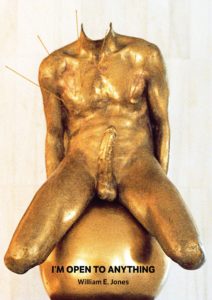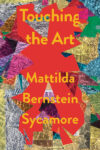 [We Heard You Liked Books; 2019]
[We Heard You Liked Books; 2019]
Toward the beginning of the novel I’m Open to Anything, the unnamed narrator graduates from college and moves home to live with his parents in an unnamed Midwestern town. His life is empty and lackluster; the most riveting time of day is when he attempts to watch porn on the family TV during the twenty minutes his father leaves to buy more booze. One morning, the narrator wakes up to a silent house. Curious, he enters his parents’ bedroom and finds his father sitting naked on the bed, dead and covered in shit and bloody vomit.
After calling for an ambulance, the narrator returns to the bedroom to stare at his father’s naked body. A long paragraph is devoted to describing his father’s penis: the coloring (darker and pinker than the rest of his flesh); circumcised or uncircumcised (foreskin intact); and length (at least eight inches long and six inches in circumference). The narrator notes the presence of a “drop of moisture” on the tip of the urethra, and contemplates the possibility that his father died with an erection. The reader is about to receive an estimation on the size of the testicles, but this calculation is interrupted by the arrival of the paramedics, who have difficulty navigating the gurney into the house. While assisting the paramedics through the garage — the front door proves too narrow to fit the gurney — the narrator realizes how small his family’s house is, how the “hallways were cramped, the doors narrow, the walls close.” “What an inappropriate thought to have in an emergency,” he thinks.
I laughed the first time I read this sentence. The narrator’s ascription of “inappropriate” to the realization of the narrowness of his home — which, on a logistical level, seems pertinent to the scene — and not to the extensive detailing of his father’s genitalia, seemed immediately humorous. And yet, after reading the sequence multiple times, I began to second-guess my own judgement. What was inappropriate about the narrator’s appraisal of his father’s naked body? And isn’t the shame of class, or rather, the fact that class and capital as a system makes us feel ashamed, inappropriate? This reading experience provided a directive for how to read the book: leave all of your assumptions — sexual, aesthetic, you name it — at the door.
I’m Open to Anything is film and visual artist William E. Jones’ first novel. Jones, who works in a variety of mediums, has shown his work at the Tate Modern, MoMa, and the Louvre, and is the author of several books of nonfiction, most recently True Homosexual Experiences: Boyd McDonald and Straight to Hell, which examines early queer ‘zine culture. Provocative is one word you might use to describe Jones; he recently arrived to a reading wearing a t-shirt bearing the slogan “Make America Gape Again” printed over a photograph of a well-stretched asshole oozing out a wad of semen. It’s not surprising, then, that Jones’ first novel is narrated from the point-of-view of a fist-fucking top.
At its most basic level, I’m Open to Anything is a play on the gay bildungsroman we’re familiar with: It’s the late 1980s, and a queer kid moves to a big city — in this case, LA — to escape the narrowness of small town American life. But anyone who has spent time on Grindr or Scruff can detect in the novel’s title the resonance of an oft repeated exchange: What are you looking for? I’m open. Openness, on gay hookup apps, usually, and paradoxically, describes a fairly limited repertoire of actions: handjobs, blowjobs, rimming, fucking. Openness can even be relational: no-strings-attached, friends-with-benefits, the ever vague “fun,” or a romantic relationship. In his novel, Jones takes this commonplace line to an extreme, creating a book-length argumentum ad absurdum: if one is truly open to anything, then why not fisting? In other words: what do we mean when we say we are open?
In I’m Open to Anything, openness functions as both an aesthetic descriptor and mode of political critique. In LA, the narrator finds work at a porn shop, an opportunity that allows him to combine two of his interests: films and porn. Film and porn history — and their intersecting points — abound throughout the novel, with digressions on Rainer Werner Fassbinder, Werner Schroeter, and Jean Genet. Fred Halsted, a famous porn actor in the 1970s (as well as a subject of Jones’ 2011 book Halsted Plays Himself), makes a semi-fictional appearance as an escort, with Jones inserting some of Halsted’s most famous quotes, such as “I consider myself a pervert first and a homosexual second,” directly into the dialogue.
The narrator’s interest in art and porn leads to an evaluation of the difference between the two. At an exhibition of Joel-Peter Witkin’s photographs, the narrator stands in awe of Arm Fuck, in which a man has inserted his entire arm — up to the shoulder — into the bottom’s ass. “Several things suggest that the photograph is a pornographic image,” the narrator says, “yet its composition is so clever, the scratches and faults in the emulsion are so obviously aesthetic, and the styling is so precise that the photograph could be nothing but art.” Pornography is given the same type of evaluation; for the narrator, porn shot on film, rather than video — a cost-saving shift that occurred in the mid-1980s — represents the aesthetic height of the genre, as the expensiveness of film made the directors more aware of action, camera placement, and lighting.
Through its discussion of art and porn, I’m Open to Anything refuses to assert that the two are mutually exclusive categories. At the same time, the novel is realistic about the consequence of this refusal, namely that most objects which are categorized as both art and porn will never reach mainstream audiences or achieve mainstream circulation. “We have all been conditioned to a neutered aesthetic in films, suitable to the taste of the aspiring middle class,” the narrator claims. Importantly, this critique doesn’t lay all the blame at the feet of the marketplace, but saves some blame for the creators who have allowed themselves to be conditioned by respectable, middle-class sentiments.
This argument obviously applies to the publishing industry as well, something which the narrator is fully aware of: “I imagined an academic or commercial environment rejecting what I wrote as pornography, yet I was compelled to write these unwelcome texts in my own way and on my own terms.” Although set in the late 80s, this sentiment still holds true: despite the recent success of some queer-themed novels, one is hard-put to find a novel with detailed scenes of kinky queer sex that has garnered mainstream attention. Materially, in 2019, I’m Open to Anything seems self-aware of itself as an outlier commodity in a literary marketplace; the cover is an image of a golden St. Sebastian, pierced with arrows, and equipped with an erect (and large) penis. The book, both in its physicality and content, poses a challenge not to conservative forces who would immediately shut it down, but rather to progressive and “open-minded” people who support queer writing — but only if it’s “literary” and respectable.
And of course, there’s the fisting. Who can say the last time they read a mainstream novel about fist-fucking? Even during the course of writing this review, as I mentioned to friends what I was writing about, they immediately laughed. Hell, I even laughed. But here again, the humor of the situation fell flat, calling into question what I found funny in the first place. Why were my friends and I chuckling? Fisting is many things, but it’s not funny. Unless, that is, we weren’t laughing about fisting per se, but rather our own discomfort with it, perhaps even our own desires to be dominated?
The novel takes fisting seriously as a means to think about the roles domination, sadism, masochism, and abjection play in the sexual desires of gay men. In the narrator’s conversation with Halsted, after the porn star recounts, with delight, a time he made a fundamentalist Christian eat shit and say “yes, sir Lord,” the famed porn star claims that “almost all gays are masochists, if not overtly, at least subliminally.” This sentiment is not new; many queer artists and scholar have studied the role abjection and domination play in our sexual practices. What is notable about this novel is how moments of domination coincide with moments of intense intimacy, even tenderness. At one point, one of the narrator’s bottoms sobs uncontrollably out of the intensity of experience. “You broke me down and made me feel totally vulnerable,” he says. And, circumventing pornographic depictions of impersonalized S/M sex, the narrator attaches a scene of talking to each hookup, making a point that he cannot have sex with someone without speaking to them.
I’m Open to Anything is an ambitious novel with a sexy topic, but these might also be its largest faults. Running at a slim 170 pages, we don’t get to a scene of fisting until almost half-way through the novel, which gives the development of the several sexual relationships a rushed feeling. Dialogue can run on, and the idiosyncrasy of the speaking character is often replaced by an editorial and essayistic voice that delivers information important for the world of the novel, but not the immediate scene.
Most troubling are the racial elements of the book. The narrator states early on his affinity for working class men, an interest he developed from watching porn. Consequently, most of the men he fists are working class Latino men, particularly immigrants. The narrator himself operates under an unmarked whiteness, and the novel flirts with the question of racial fetishism: the narrator seems to have a proclivity for Latino men, and some of the Latino men only want to be fisted by white men. Racialized fetishism has been explored before — the work of Gary Fisher and M. Lamar come to mind — but Jones doesn’t do the work necessary to explore and critique racialized fetishes, or to ask how they exist in a society saturated by white supremacy. What the reader is left with is an unnamed White male narrator whose racialized sex remains critically — and problematically — unexamined.
I ultimately walked away from the novel challenged and amused, but also wanting a more fully-fleshed out book, one that spent as much time on its characters as it did thinking about film, history, and pornography. The irony was that in a book so laser focused on debates about what makes a piece pornographic or artistic, the novel often skimps out on the stuff that makes a novel a work of art: character development, plot, a narrative arc. Of course, all novels don’t share these elements, but wouldn’t it have been just as radical for the novel to fully inhabit the world of the sex radicals it so ferociously defends? In a recent interview, Jones said he’s at work on another novel. I’m open to seeing where he goes from here.
Joshua Gutterman Tranen is a queer Jewish writer. He lives in Durham, NC, with his dog, Maggie.
This post may contain affiliate links.







